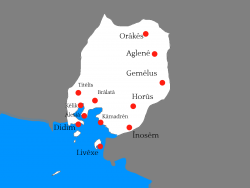Archive:Lons
| The Humble Debayenan People's Republic of Lons Sêtêv Vokêus Dêbaiênâm Usê ênLôns |
||||||
|---|---|---|---|---|---|---|
|
||||||
| Motto: "Înz âl pâlu rêkan, af âl odorê kumsan." ("To crackle in the sands, to burn on the waters.") | ||||||
| Anthem: êvLôns, mêm-êv dudûm êtêv viê | ||||||
Map of Lons containing the major cities.
|
||||||
| Capital and largest city | Alesia | |||||
| Official languages | Lonish | |||||
| Recognised regional languages | Asmalish, Paluzavroran | |||||
| Ethnic groups (2013) | Lonish (82%), Ethnic Koklatean (13%), Azeri (2%), Other (3%) | |||||
| Demonym | Lonish | |||||
| Government | ||||||
| - | President | Feês Havôn | ||||
| - | Vice President | Gârdân Briktâz | ||||
| - | King of Kelik | Rudlâm III | ||||
| Legislature | Parliament | |||||
| - | Upper house | Grand Counsil | ||||
| - | Lower house | Small Counsil | ||||
| Independent | ||||||
| - | Formation of the Kelik Kingdom | 12th of February, 1378 | ||||
| - | Expansion to the Kingdom of Lons | 23~26th of August, 1429 | ||||
| - | Formation of the Great Lonish Kingdom | 2nd of June, 1663 | ||||
| - | Formation of the Debayenan Republic of Lons | 30th of September, 1743 | ||||
| - | Formation of the Debayenan People's Republic of Lons | 4th of December, 1774 | ||||
| - | Instatement of the Humble Debayenan People's Republic of Lons | 16th of May, 1955 | ||||
| Area | ||||||
| - | 1,425,684 km2 550,460 sq mi |
|||||
| Population | ||||||
| - | 2015 estimate | 46200000 | ||||
| - | 2012 census | 46084425 | ||||
| - | Density | 32.405/km2 83.9/sq mi |
||||
| Gini (2012) | 48 high |
|||||
| HDI (2014) | 0.82 very high |
|||||
| Currency | Lastinus (LLS) | |||||
| Time zone | SCT+2 (SCT+2) | |||||
| - | Summer (DST) | not observed (SCTnot observed) | ||||
| Date format | dd-mm-yyyy, AD | |||||
| Drives on the | right | |||||
| Calling code | +54 | |||||
| Internet TLD | .ls | |||||
Lons (IPA: //, Native language: êvLôns, IPA: //), officially the Humble Debayenan People's Republic of Lons, is a country located on the southern shore of the Western peninsula of Baredina. It consists of three regions, Lons, Koklates and Asmal, and several islands off the coast. It borders Azerin and Barradiwa.
Etymology
It is generally believe the name Lons is from the Lonish word lôn, meaning field, earth or owned farmland. Documents have been found showing the early name of the kingdom to be Konâsrât neân-ês Lôn êts Od (Kingdom of our Land and Water).
History
The first historical event that lead to the birth of Lons was the formation of the Kelik Kingdom. While several city-states had ruled the area in the time before this, the ruling general of Kêlik, Dâstum I, had begun to conquer the lands slowly, and on the 12th of February, 1378, he declared himself King of the Keliker lands. In 1429, under rule of Dâstum III, the kingdom made the great expansion to include the islands Frêlus and Ûrnavivos and the majority of current day district Vêsêv Lôns, which created the kingdom of Lons, or rather, the Kingdom of Our Land and Water (see above). In 1663, the Kingdom of Lons merged into the Great Lonish Kingdom, taking shape more akin to the current day's Lons. It now included Âsmal, as well as parts of the desert to the north, once belonging to the XXX empire. The seat of reign was moved to Âlesiâ, current king Sabir II's favorite city. Eighty years later, under rule of King Dâstum IX, revolution sprouted, fueled by the lack of religious freedom and representation under the kingdom. Dâstum IX was overthrown, and the people instated a new government, instated by the Debayen Church. This theocracy, however, didn't last very long, as in 1777, during the rule of Zimân Ostribêx, the people rose once more, and demanded the formation of a senate and fair elections. It happened, and, until 1955, when the senate became defunct, every two years, the people voted for their Great Council. From 1955 onwards, elections were held every three years, or when the current president was removed from his duty, or when the cabinet fell. The current president of Lons is Feês Havôn.
Geography
Lons is found on the western peninsula of Baredina, on the southern coast. It has 3 peninsulas on this shore, and has four islands.
Geology
In the north, Lons is largely desert, with few cities or signs of life. The southern part, the regions of Lons (Region) and Âsmal, are less hot, and contain various forms of vegetation. Eastern Lons also has the Pâlzumôn Range.
Climate
The desert in the north are very hot, and contain little to no rainfall. Further south, Lons is warm all year round, with a rain season between June and August.


